 Get premium membership
Get premium membership and access questions with answers, video lessons as well as revision papers.
(a) (i) Pisces
(ii) Aquatic
(iii) Have gills for gaseous exchange
(b) (i) fish gills, gills
(ii) Site for gaseous exchange
(iii) Operculum
(iv) - Have numerous gill filaments to increase the surface area for gaseous exchange.
- Have gill rakers to trap food particles and solid materials which may damage the delicate gill
filaments.
- Have thin epithelium (blood visible) to reduce diffusion distance hence faster exchange of
respiratory gases.
(c) (i) Trachea
(ii) It is tubular; hollow ; it has ring of cartilage.
(iii) - Tubular/hollow to transport respiratory gases ;
sharon kalunda answered the question on May 27, 2019 at 10:54
- Study the photographs and answer the following questions.
I) The photograph in Plate 5 shows the germination process in a species of legume.
(a) (i) Name the...(Solved)
Study the photographs and answer the following questions.
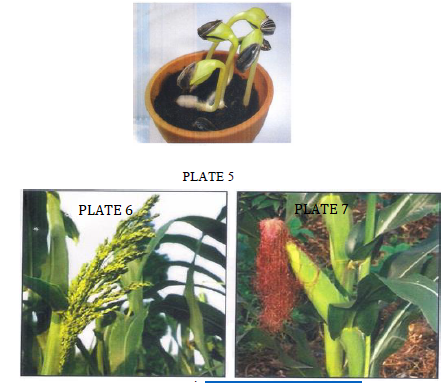
I) The photograph in Plate 5 shows the germination process in a species of legume.
(a) (i) Name the type of germination shown in the photograph.
(ii) Give a reason for your answer.
(b) Other than germination the seedling have shown some responses.
(i) Name two responses shown in the photograph.
(ii) State one survival value of each of the response named above.
(II) Examine the photograph in Plate 6 and Plate 7 which show different essential parts of a flower of a species on two different plants.
(a) Name the flower parts shown in Plate 6 and Plate 7.
(b) (i) Name the phenomenon described in the statement above.
(ii) Explain the significance of the phenomena stated in (a)(i) above.
(c) (i) State the mode of pollination of the flower shown in the photograph.
(ii) Give a reason for your answer.
(d) (i) State the type of pollination of the flower shown in the photograph.
(ii) Give two reasons for your answer.
Date posted: May 27, 2019. Answers (1)
- Below are drawing of various organisms. Examine them.
i ) Name the phylum to which B belongs.
ii) Give three reasons for your answer in (a) (i)...(Solved)
Below are drawing of various organisms. Examine them.
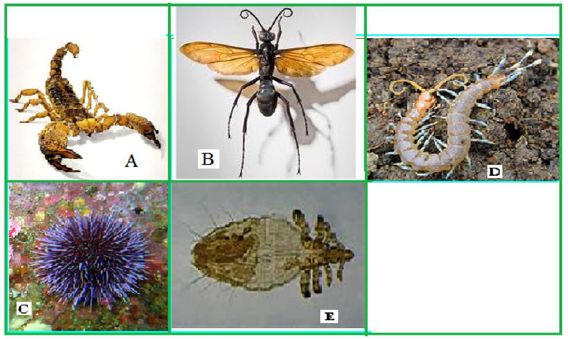
i ) Name the phylum to which B belongs.
ii) Give three reasons for your answer in (a) (i) above.
b) Name the class to which specimen A belongs.
c) Give three differences between specimen B and E.
d)Use the dichotomous key provided to identify the organism.
a) Jointed legs present............................................................................ go to 2
b) Jointed legs absent.............................................................................. go to 7
a) Have 3 pairs of legs............................................................................ go to 3
b) Have more than 3 pairs of legs........................................................... go to 5
a) With wings.......................................................................................... go to 4
b) Without wings.................................................................................... Anoplura
a) Have one pair of wings....................................................................... Diptera
b) Have two pairs of wings..................................................................... Hymenoptera
a) Have four pairs of legs........................................................................ Arachnida
b) Have more than 10 pairs of legs.......................................................... go to 6
a) With one pair of legs per segment...................................................... Chilopoda
b) With two pairs of legs per body segment........................................... Diplopoda
a) With body enclosed in a shell............................................................. Mollusca
b) Body surface with spiny projections................................................... Echinodermata.
Identify steps followed to identify organism A, B, C, and E

Date posted: May 27, 2019. Answers (1)
- i)Identify the type of ovary shown in the photographs below.
ii) Name the parts labeled K and L
iii)Identify the type of section shown in the...(Solved)
i)Identify the type of ovary shown in the photographs below.
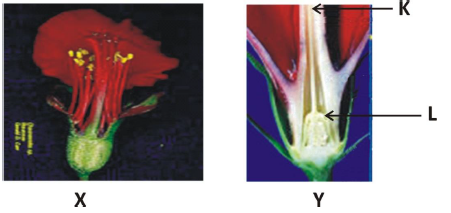
ii) Name the parts labeled K and L
iii)Identify the type of section shown in the photographs X and Y above.
Date posted: May 27, 2019. Answers (1)
- The photographs below show different plants.
a) Name the class of the plants from which the photographs were taken.
b) Name the agent of pollination for the...(Solved)
The photographs below show different plants.
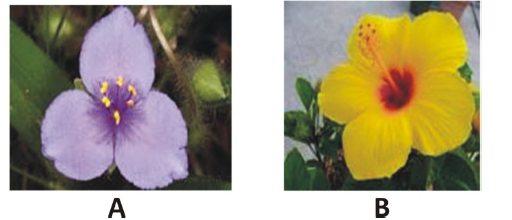
a) Name the class of the plants from which the photographs were taken.
b) Name the agent of pollination for the flowers in the photographs above.
c) State one observation on the photographs that support your answer in (b) above.
Date posted: May 27, 2019. Answers (1)
- Describe the effects of the various abiotic factors in a terrestrial ecosystem to plants.(Solved)
Describe the effects of the various abiotic factors in a terrestrial ecosystem to plants.
Date posted: May 27, 2019. Answers (1)
- Describe the role of the mammalian liver in carbohydrate metabolism.(Solved)
Describe the role of the mammalian liver in carbohydrate metabolism.
Date posted: May 27, 2019. Answers (1)
- In an experiment, lactic acid concentration was measured before, during and after exercise to determine the effect of exercise on the concentration of lactic acid...(Solved)
In an experiment, lactic acid concentration was measured before, during and after exercise to determine the effect of exercise on the concentration of lactic acid in blood. Study the data obtained and use it to answer the questions that follow.

a) Plot a graph of the concentration of lactic acid against time using a suitable scale. (6 marks)
b) From the graph:
i) Determine the period of exercise.
ii) Explain
c) i) Determine the time when oxygen debt incurred.
ii) Explain
d) i) The duration it took to pay back the oxygen debt
ii) Explain
e) Plot a hypothetical curve for oxygen intake during the experimental period on the same axes.
f) Why does lactic acid level usually continue to rise in the blood after the exercise ceases?
g) State two of effects of lactic acid on tissues.
Date posted: May 27, 2019. Answers (1)
- Name the gland associated with the secretion of aldosterone hormone.(Solved)
Name the gland associated with the secretion of aldosterone hormone.
Date posted: May 27, 2019. Answers (1)
- The diagram below is a longitudinal section of an organ in mammals.
a) Name the organ.
b) Identify the parts R and S.
c) i) State three...(Solved)
The diagram below is a longitudinal section of an organ in mammals.
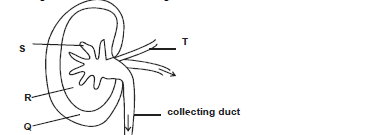
a) Name the organ.
b) Identify the parts R and S.
c) i) State three differences in the structure above found in the desert rat and fish.
ii) Account for the differences stated above.
(d) Name the gland associated with the secretion of aldosterone hormone.
Date posted: May 27, 2019. Answers (1)
- The diagram below is a cross section of a portion of alimentary canal.
a) i) Which part of the alimentary canal is represented by the portion...(Solved)
The diagram below is a cross section of a portion of alimentary canal.

a) i) Which part of the alimentary canal is represented by the portion above.
ii) Give a reason for your answer in (a) (i) above.
b) i) State two functions of the part of alimentary canal represented above.
ii) Explain two structural adaptations of the part of alimentary canal represented above.
Date posted: May 27, 2019. Answers (1)
- The colour of tips of hair in Shepherd dog is controlled by a gene with three alleles B for Black, R for red and C...(Solved)
The colour of tips of hair in Shepherd dog is controlled by a gene with three alleles B for Black, R for red and C for copper.
A cross between pure breeding red and copper hair tips produce offsprings with scarlet hair tips. Crossing pure breeding
red and black hair tips yields all red offsprings. A cross between pure breeds of copper and black produce offsprings that
are all copper.
a) Comment on the inheritance of the three alleles B, R and C.
b) A dog breeder wishes to know the genotype of a dog with red hair tips. State and explain the cross needed to determine
the dog’s genotype.
c) A mother of blood group AB was married to a man of blood group B heterozygous. What is the probability that one of
their sons would be blood group A? Show your working.
Date posted: May 27, 2019. Answers (1)
- Give three types of movable joints found in mammalian skeleton.(Solved)
Give three types of movable joints found in mammalian skeleton.
Date posted: May 27, 2019. Answers (1)
- Distinguish between exocrine and endocrine glands.(Solved)
Distinguish between exocrine and endocrine glands.
Date posted: May 27, 2019. Answers (1)
- The diagram below shows an eye defect.
Using a diagram show how the defect can be corrected.(Solved)
The diagram below shows an eye defect.

Using a diagram show how the defect can be corrected.
Date posted: May 27, 2019. Answers (1)
- What is the significance of the high tail power in fish locomotion.(Solved)
What is the significance of the high tail power in fish locomotion.
Date posted: May 27, 2019. Answers (1)
- The length from tail tip to the anus in a fish is 8cm whereas that from tail tip is 24cm. Calculate the tail power of...(Solved)
The length from tail tip to the anus in a fish is 8cm whereas that from tail tip is 24cm. Calculate the tail power of the fish.
Date posted: May 27, 2019. Answers (1)
- Below is a nucleic strand.
a) Name the nucleic acid.
b) Give a reason for your answer in (a) above.
c) Write down the complimentary base...(Solved)
Below is a nucleic strand.

a) Name the nucleic acid.
b) Give a reason for your answer in (a) above.
c) Write down the complimentary base pairing the pattern in the nucleic acid formed above.
Date posted: May 27, 2019. Answers (1)
- The diagram below represents a young root and four cells which occur in different regions of the root tip labelled K, L, M
and N.
State the...(Solved)
The diagram below represents a young root and four cells which occur in different regions of the root tip labelled K, L, M
and N.
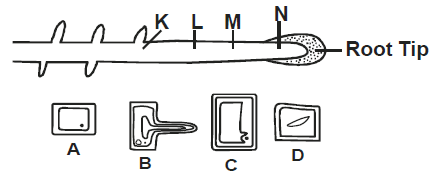
State the regions of the root tip where each of the cells A B C D occur.
Date posted: May 27, 2019. Answers (1)
- List two possible effects that are likely to occur if the maternal and foetal circulatory system were directly connected.(Solved)
List two possible effects that are likely to occur if the maternal and foetal circulatory system were directly connected.
Date posted: May 27, 2019. Answers (1)
- The diagram below shows a cell undergoing a stage in a cell division.
a) Identify the stage.
b) Give a reason for your answer in (a) above....(Solved)
The diagram below shows a cell undergoing a stage in a cell division.
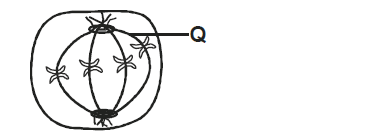
a) Identify the stage.
b) Give a reason for your answer in (a) above.
Date posted: May 27, 2019. Answers (1)